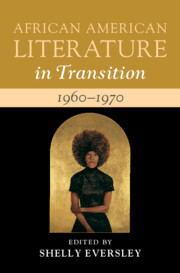Book contents
- African American Literature in Transition, 1960–1970
- African American Literature In Transition
- African American Literature in Transition, 1960–1970
- Copyright page
- Contents
- Contributors
- Preface
- Acknowledgments
- Chronology
- Introduction
- I Poetry and Music
- Chapter 1 The Society of Umbra and the Coming of the Black Aesthetic
- Chapter 2 Robert Hayden, the Black Arts Movement, and the Politics of Aesthetic Distance
- Chapter 3 Breathing
- Chapter 4 Reconsidering “the Revolution in Music”
- II Culture and Politics
- III Beyond the Canon
- Index
- References
Chapter 4 - Reconsidering “the Revolution in Music”
from I - Poetry and Music
Published online by Cambridge University Press: 10 November 2022
- African American Literature in Transition, 1960–1970
- African American Literature In Transition
- African American Literature in Transition, 1960–1970
- Copyright page
- Contents
- Contributors
- Preface
- Acknowledgments
- Chronology
- Introduction
- I Poetry and Music
- Chapter 1 The Society of Umbra and the Coming of the Black Aesthetic
- Chapter 2 Robert Hayden, the Black Arts Movement, and the Politics of Aesthetic Distance
- Chapter 3 Breathing
- Chapter 4 Reconsidering “the Revolution in Music”
- II Culture and Politics
- III Beyond the Canon
- Index
- References
Summary
Focusing on recently come-to-light recordings of interviews with musicians conducted by jazz critic and historian Frank Kofsky, this essay takes as its point of departure a reconsideration of Kofsky’s influential yet controversial theories about the transformations (creative and political) occurring in the jazz world during the Black Arts Movement era. The essay notes how the interviews showcase an analytical nuance that many of Kofsky’s critics do not recognize, but still shows how he might have theorized the “revolution in music” differently if he had listed to his interviewees more carefully. Musicians’ comments, the essay suggests, help us understand the multiplicity of the so-called jazz revolution in ways that exceed any simple notions of politics or identity. They also help us understand how the weight of political expectation vis-à-vis “the Black community” and “the revolution” was itself an aesthetically productive force, whether musicians were working with or against it.
- Type
- Chapter
- Information
- African American Literature in Transition, 1960–1970Black Art, Politics, and Aesthetics, pp. 90 - 116Publisher: Cambridge University PressPrint publication year: 2022

